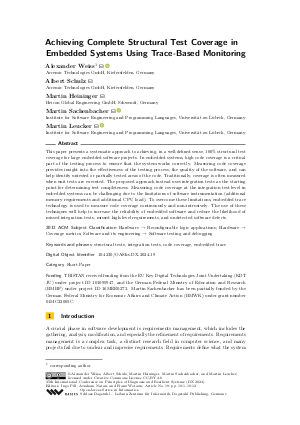Achieving Complete Structural Test Coverage in Embedded Systems Using Trace-Based Monitoring (Short Paper)
Authors
Alexander Weiss  ,
Albert Schulz,
Martin Heininger,
Martin Sachenbacher
,
Albert Schulz,
Martin Heininger,
Martin Sachenbacher  ,
Martin Leucker
,
Martin Leucker 
-
Part of:
Volume:
35th International Conference on Principles of Diagnosis and Resilient Systems (DX 2024)
Part of: Series: Open Access Series in Informatics (OASIcs)
Part of: Conference: International Conference on Principles of Diagnosis and Resilient Systems (DX) - License:
 Creative Commons Attribution 4.0 International license
Creative Commons Attribution 4.0 International license
- Publication Date: 2024-11-26
File

PDF
OASIcs.DX.2024.19.pdf
- Filesize: 2.87 MB
- 12 pages
Document Identifiers
Subject Classification
ACM Subject Classification
- Hardware → Reconfigurable logic applications
- Hardware → Coverage metrics
- Software and its engineering → Software testing and debugging
Keywords
- structural tests
- integration tests
- code coverage
- embedded trace
Metrics
- Access Statistics
-
Total Accesses (updated on a weekly basis)
0PDF Downloads0Metadata Views
Abstract
This paper presents a systematic approach to achieving, in a well-defined sense, 100% structural test coverage for large embedded software projects. In embedded systems, high code coverage is a critical part of the testing process to ensure that the system works correctly. Measuring code coverage provides insight into the effectiveness of the testing process, the quality of the software, and can help identify untested or partially tested areas of the code. Traditionally, coverage is often measured when unit tests are executed. The proposed approach instead uses integration tests as the starting point for determining test completeness. Measuring code coverage at the integration test level in embedded systems can be challenging due to the limitations of software instrumentation (additional memory requirements and additional CPU load). To overcome these limitations, embedded trace technology is used to measure code coverage continuously and non-intrusively. The use of these techniques will help to increase the reliability of embedded software and reduce the likelihood of missed integration tests, missed high-level requirements, and undetected software defects.
Cite As Get BibTex
Alexander Weiss, Albert Schulz, Martin Heininger, Martin Sachenbacher, and Martin Leucker. Achieving Complete Structural Test Coverage in Embedded Systems Using Trace-Based Monitoring (Short Paper). In 35th International Conference on Principles of Diagnosis and Resilient Systems (DX 2024). Open Access Series in Informatics (OASIcs), Volume 125, pp. 19:1-19:12, Schloss Dagstuhl – Leibniz-Zentrum für Informatik (2024)
https://doi.org/10.4230/OASIcs.DX.2024.19
BibTex
@InProceedings{weiss_et_al:OASIcs.DX.2024.19,
author = {Weiss, Alexander and Schulz, Albert and Heininger, Martin and Sachenbacher, Martin and Leucker, Martin},
title = {{Achieving Complete Structural Test Coverage in Embedded Systems Using Trace-Based Monitoring}},
booktitle = {35th International Conference on Principles of Diagnosis and Resilient Systems (DX 2024)},
pages = {19:1--19:12},
series = {Open Access Series in Informatics (OASIcs)},
ISBN = {978-3-95977-356-0},
ISSN = {2190-6807},
year = {2024},
volume = {125},
editor = {Pill, Ingo and Natan, Avraham and Wotawa, Franz},
publisher = {Schloss Dagstuhl -- Leibniz-Zentrum f{\"u}r Informatik},
address = {Dagstuhl, Germany},
URL = {https://drops.dagstuhl.de/entities/document/10.4230/OASIcs.DX.2024.19},
URN = {urn:nbn:de:0030-drops-221115},
doi = {10.4230/OASIcs.DX.2024.19},
annote = {Keywords: structural tests, integration tests, code coverage, embedded trace}
}
Author Details
- Institute for Software Engineering and Programming Languages, Universität zu Lübeck, Germany
Funding
TRISTAN received funding from the EU Key Digital Technologies Joint Undertaking (KDT JU) under project ID 101095947, and the German Federal Ministry of Education and Research (BMBF) under project ID 16MEE0273. Martin Sachenbacher has been partially funded by the German Federal Ministry for Economic Affairs and Climate Action (BMWK) under grant number 01MC22005C.
References
- CEDARtools. Available: URL: https://accemic.com/cedartools/.
-
Aurora Protocol Specification, 2007. Technical Report, Xilinx Inc.

-
IEC 61508:2010 Functional safety of electrical/ electronic/programmable electronic safety-related systems, 2010.

-
DO-178C, Software Considerations in Airborne Systems and Equipment Certification, December 2011.

-
EN 50128:2011 Railway applications - Communication, signalling and processing systems - Software for railway control and protection systems, 2011.

-
MIPI PTI v2.0 Specification for Parallel Trace Interface, May 2011. Technical Report, MIPI Alliance, Inc.

- DWARF Debugging Information Format Version 5, February 2017. Available: URL: http://www.dwarfstd.org.
-
ISO 26262:2018. Road vehicles – Functional safety, 2018.

- Codebeamer. Available: URL: https://www.ptc.com/en/products/codebeamer.
- GCC Bug-tracking System. Available: URL: https://gcc.gnu.org/bugzilla/.
- Gcov. Available: URL: https://gcc.gnu.org/onlinedocs/gcc/Gcov.html.
- MappingSpace. Available: URL: https://www.ytdevops.com/home.
- NASA lessons. Available: URL: https://llis.nasa.gov/lesson/1196.
- Polarion. Available: URL: https://plm.sw.siemens.com/en-US/polarion/.
- RISC-V. Available: URL: https://riscv.org/.
- The TRISTAN Project. Available: URL: https://tristan-project.eu/.
-
K. J. Hayhurst, D. S. Veerhusen, J. J. Chilenski, and L. K. Rierson. A practical tutorial on modified condition/decision coverage. Technical report, NASA Langley Technical Report Server, 2001.

-
Martin Leucker, Martin Sachenbacher, Simon Wegener, Alexander Weiss, and Albert Schulz. Non-intrusive, continuous trace-based monitoring and its applications for system correctness, safety, and resilience. In Workshop on Principles of Diagnosis (DX'23), 2023.

- T. B. Preußer, S. Gautham, A. D. Rajagopala, C. R. Elks, and A. Weiss. Everything you always wanted to know about embedded trace. Computer, 55(2):34-43, February 2022. URL: https://doi.org/10.1109/MC.2021.3098965.
-
Tim Weilkiens, Jesko G. Lamm, Stephan Roth, and Markus Walker. Model-Based System Architecture. Wiley Series in Systems Engineering and Management. John Wiley & Sons, 2nd edition, 2022.

